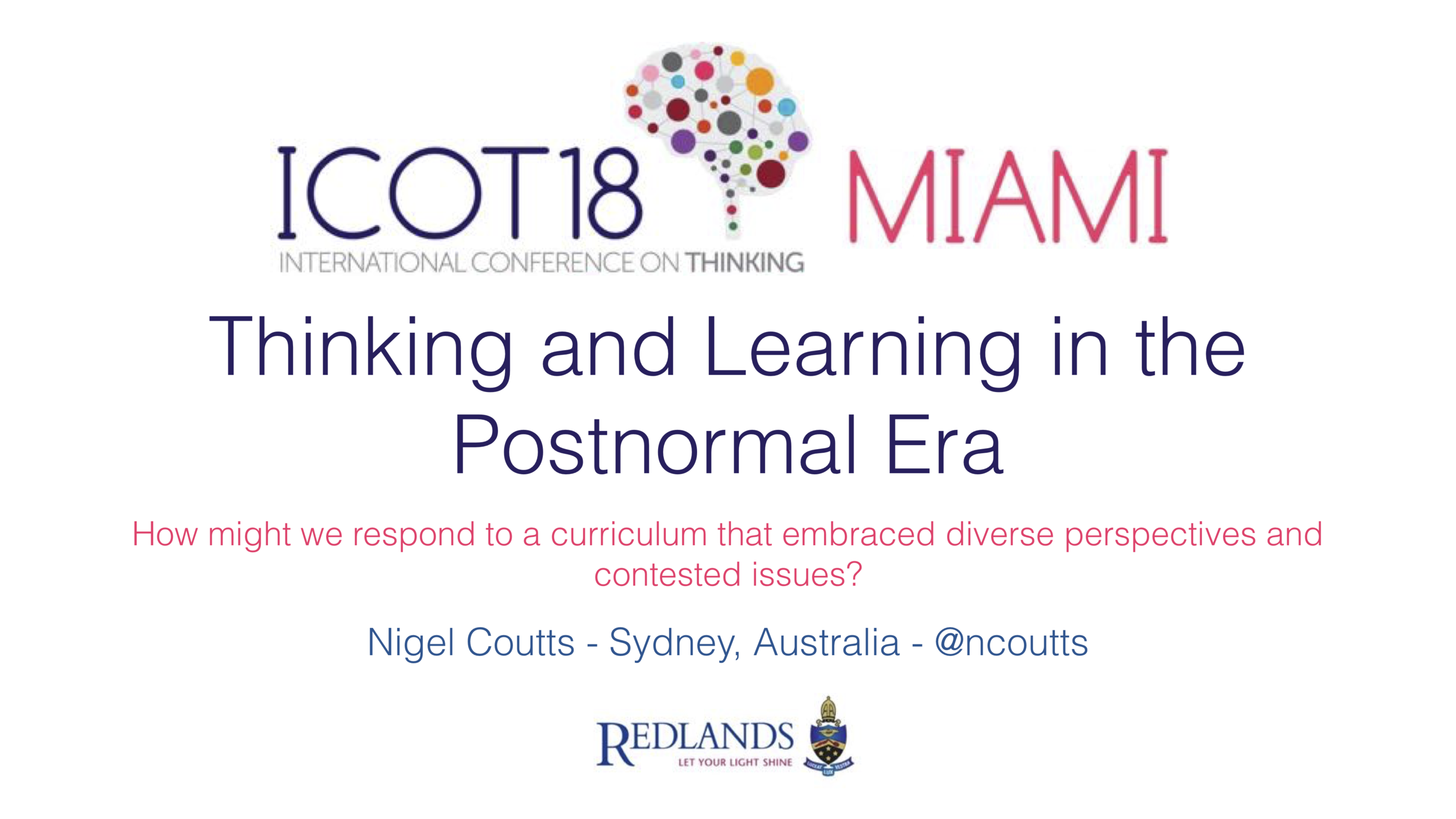Change is the background noise of the modern workplace. The constant force that winds its way into all we do. Thanks to forces such as technology, globalisation, ever expanding communication networks and global warming, living with change has become almost normal. At the forefront of our response to change lies education. If the young people of today are to thrive beyond the walls of the classroom they will need to be able to cope with a world characterised by volatility, uncertainty, complexity and ambiguity. The children of todays Kindergarten will enter the workplace in the fourth-decade of the 21st Century. We debate the merits of teaching 21st Century Skills and what they might be while teaching children who have lived their entire lives in that very century.
Increasingly the message from those who are hiring and educating young adults, from those analysing the demands of work and life in contemporary times is that education needs to change and change rapidly. In Australia, the Foundation for Young Australians has produced multiple reports that detail the skills and dispositions children will need. In the United States, multiple research projects point to a workforce that will require more preparation, higher social or analytical skills and where continuous training is the norm. (See Pew Research) On a global level the OECD has presented their ‘Future of Work’ report and share that
‘Globalisation, technological progress and demographic change are having a profound impact on OECD labour markets, affecting both the quantity and quality of jobs that are available, as well as how and by whom they are carried out. The future of work offers unparalleled opportunities, but there are also significant challenges associated with these mega-trends.’
Other changes to the shape of work and life in the coming years result from ongoing trends in artificial intelligence, automation and the rise of the ‘gig’ economy where freelance and short term contract work is common and training and retraining for new projects is the norm. In this economy, it is more important to be able to learn than it is to be learned.
What is very clear is that change is not going away. The challenge is how will schools and individual teachers respond to this drive for urgent change.
How we respond to change varies immensely. From experience with driving change and from conversations and observations with individuals as they approach change in various forms it seems that there are broad typologies which emerge along a continuum from those who actively seek to change to those who actively resist it.
There are those for whom change is the next adventure. They are happy to embrace change and are likely to be strong advocates for it. These are either the initiators or first followers of change. For the leader seeking to implement change in an organisation this group at first make things easy and during the early phases of a change initiative you might wish everyone was as adventurous as these happy folk. The trouble is however rapid the pace of change it will not be sufficient for those who love change almost for change’s sake. They will quickly grow frustrated and while the advocate for change they may do so in a manner that ostracises others. They are also likely to move on to the next new thing just as quickly as they jumped on board with the last and as a result no change is ever fully implemented. The great idea they embrace today will be tomorrow’s old thing and while the revel in the journey everyone else gets ‘change fatigue’.
There are those who are open to change but need to be shown the evidence. They ask questions, seek clarification, engage in research of their own and challenge assumptions. They can seem difficult at times and even appear adversarial but when you understand their motivation and feed them the information they desire they are likely to become some of your strongest supporters (at least amongst others like them). These are the ones who will want the full version of the report. Who will read the twenty page document outlining the change and then ask for copies of the referenced research papers. The quick and dirty snapshot is likely to get this group off side and they will complain about a lack of detail.
There are those who need to be show how the change will impact them. They want the human side of the story and while this group also craves details they do not need charts and data but stories of how the change will be ‘felt’ within the organisation. In schools much of their focus will be on how the change will effect the students but they will also want to know about the impact it might have on their colleagues. Will this create more work, will there be time to adjust, will there be support, who will this change impact. This group are likely to look at the real world impact of the change and are likely to back their concerns with ‘tales from the coal-face’. Show them the human face of the change and how it will make their lives better and they will get on board. Smothering them with data and jargon is likely to make them suspicious.
There are also those who just want to be told what to do. They don’t really buy into the change; they don’t resist it either. They are not impressed by the research or the stories of how this will change their lives for the better. They want the snapshot version and the chance to get on with what they have to do. This group might make the process of change easy to implement but they are not likely to help you win supporters who don’t have a similar mindset and the more subtle elements of complex change will be entirely lost to them.
There are those who publicly embrace the change but in the privacy of the classroom continue as they have always done. These are the ones who have seen change come and go and have learned that by keeping their head down they can wait out this new initiative. Some will believe that they have indeed adopted the change but the reality is that do not fully understand it. Others will believe that the new idea is precisely what they have always done and again they are not understanding the new approach. Deprivatising education has many advantages including sharing best practices, enhancing collegiality and promoting collaboration; it also makes visible those who passively resist change.
There are those who are outright afraid of change. These are often the ones who are the most outspoken advocates of the status quo. They are likely to attack those initiating the change and will claim that it is too complicated, has been poorly articulated and is ill conceived. They may not have strong arguments for why things should stay as they are and they are not likely to be persuaded by reason. Once you recognise that the reaction you are seeing is driven by fear you can start to address the real issues for this group. This is a group that will definitely require one to one time and who need to see that the change is manageable. They are more likely to be persuaded to give new ideas a go by their close peers than by management. When they do come around they are likely to bring others with them.
In schools, emotion and culture are linked and change of culture frequently invokes an emotional response. “A person’s sense of identity is partly determined by his or her values, which can mesh or clash with organizational values” (Smollan & Sayers 2009 p439) When cultural change is sought in a school and it is not viewed as fitting with one’s values or it calls those values into question emotional responses such as fear, anger or sadness are common.
There are of course also those for whom the change is just wrong. They understand it, they have looked at the research, listened to the rhetoric and don’t buy any of it. As author of “Good to Great”, Jim Collins might note, these are the people who have found themselves on the wrong bus and in the wrong seats. They are likely to be great people and given the right context could do great things but if they cannot find a way to align their core beliefs with the organisations vision for change they are unlikely to be truly happy. If you are leading people like this, you might find ‘Radical Candor’ by Kim Scott illuminating. Helping people find the right place, the place where they fit is the best service we can provide those who are on the wrong bus. If you are feeling like you are on the wrong bus it might be time to read Simon Sinek’s ‘Start with Why’ and explore how doing so can help you find meaning within an organisation or point you in the right direction.
Change is always complicated. A the least it involves people, personalities, cultures, beliefs, values, emotions and identity. Change initiatives have a habit of failing and do so even when all the right steps seem to have been made. Chaos theory loves change inside complex organisations and schools are indeed complex enough to ensure the results of change efforts will be unpredictable. If we at least seek to understand the motivations and perspectives of those involved in the change, we have a chance of making the right moves.
By Nigel Coutts
Scott, K. (2017) Radical Candor: How to be a great boss without losing your humanity. Macmillan: UK
Sinek, S. (2011) Start with why: How great leaders inspire everyone to take action. Portfolio Penguin: London
Smollan, R & Sayers, J. (2009) Organizational Culture, Change and Emotions: A Qualitative Study, Journal of Change Management, 9:4, 435-457
Foundation for Young Australians
Deloitte - Futures of Work
Key findings about the American workforce and the changing job market
Good to Great - Article by Jim Collins






















